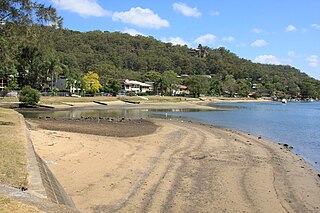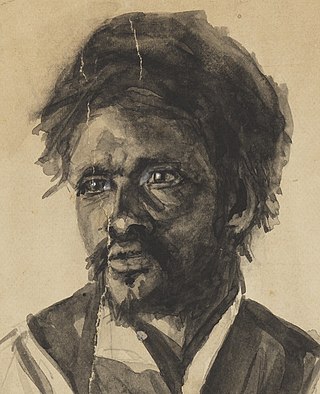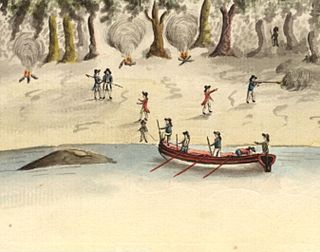History of contact
By the late 1790s, the Hawkesbury River area was claimed by more than 400 British settlers. The farms made by the settlers were barriers to the river and to the food supply of the Dharug people, who were rightly upset by this invasion. The Dharug who crossed the farms to pick up corn were killed by the settlers, so they organized raids to burn the crops. The conflict scaled and in 1795 the government provided troops to protect the farms. The bodies of any Dharug killed were to be put in iron gibbets and hung from trees as a warning. In 1801, Governor King ordered troops to patrol farms on the Georges River and shoot any Dharug on sight. The guerrilla was so effective that in 1816 Governor Macquarie forbade Aboriginals to carry any weapons within two kilometres of a house or a town or to congregate in groups bigger than six. He also authorised settlers to establish vigilante groups and the creation of three new military outposts.
A group led by Pemulwuy made a daring raid on Parramatta, where he was severely wounded and fled. His band was accused of killing four settlers and falsely accused of raping women. The government issued orders for his capture, dead or alive. He was killed by two settlers in 1802, and his head was severed, pickled and dispatched by King to Sir Joseph Banks. To date Pemulwuy's head has not been returned and he has not had a proper burial. It is 'lost' in the British Museum in London. Pemulwuy's son, Tedbury, raided farms until 1810. Another famous raider was Mosquito. He led a group for two decades, until he was captured and hanged in Van Diemen's land in 1823.
Smallpox, introduced in 1789 by the British, wiped out up to 90% of the population in some areas. They lived in the natural caves and overhangs in the sandstone of the Hawksbury region, although some did choose to make huts out of bark, sticks and branches.

The Wangal people are a clan of the Dharug Aboriginal people whose heirs are custodians of the lands and waters of what is now the Inner West of Sydney, New South Wales, centred around the Municipality of Strathfield, Municipality of Burwood, City of Canada Bay and former Ashfield Council and extending west into the City of Parramatta.

The Eora are an Aboriginal Australian people of New South Wales. Eora is the name given by the earliest European settlers to a group of Aboriginal people belonging to the clans along the coastal area of what is now known as the Sydney basin, in New South Wales, Australia. The Eora share a language with the Darug people, whose traditional lands lie further inland, to the west of the Eora.

Pemulwuy was a Bidjigal warrior of the Dharug, an Aboriginal Australian people from New South Wales. One of the most famous Aboriginal resistance fighters in the colonial era, he is noted for his resistance to European colonisation which began with the arrival of the First Fleet in January 1788.

Woronora is a suburb in southern Sydney, in the state of New South Wales, Australia. Woronora is located 27 kilometres south of the Sydney central business district, in the local government area of the Sutherland Shire. Woronora Heights is a separate suburb, to the south-west.
Yarramundi was an Indigenous Australian called by Europeans "the chief of the Richmond Tribe" or "Tribes". He was a member of the Boorooberongal clan of the Darug people, and was a garadyi or "doctor".
The Gadigal, also spelled as Cadigal and Caddiegal, are a group of Aboriginal people whose traditional lands are located in Gadi, on Eora country, the location of Sydney, New South Wales, Australia. However, since the colonisation of Australia, most Gadigal people have been displaced from their traditional lands

The Dharug language, also spelt Darug, Dharuk, and other variants, and also known as the Sydney language, Gadigal language, is an Australian Aboriginal language of the Yuin–Kuric group that was traditionally spoken in the region of Sydney, New South Wales, until it became extinct due to effects of colonisation. It is the traditional language of the Dharug people. The Dharug population has greatly diminished since the onset of colonisation. The term Eora language has sometimes been used to distinguish a coastal dialect from hinterland dialects, but there is no evidence that Aboriginal peoples ever used this term, which simply means "people". Some effort has been put into reviving a reconstructed form of the language.

Kuringgai is an ethnonym referring to an Indigenous Australian people who once occupied the territory between the southern borders of the Gamilaraay and the area around Sydney, and an historical people with its own distinctive language, located in part of that territory.

The Gandangara people, also spelt Gundungara, Gandangarra, Gundungurra and other variations, are an Aboriginal Australian people in south-eastern New South Wales, Australia. Their traditional lands include present day Goulburn, Wollondilly Shire, The Blue Mountains and the Southern Highlands.

Musquito was an Indigenous Australian resistance leader, convict hunter and outlaw based firstly in the Sydney region of the British colony of New South Wales and later in Van Diemen's Land.

The Tharawal people and other variants, are an Aboriginal Australian people, identified by the Yuin language. Traditionally, they lived as hunter–fisher–gatherers in family groups or clans with ties of kinship, scattered along the coastal area of what is now the Sydney basin in New South Wales.

The Bidjigal people are an Aboriginal Australian people whose traditional lands are modern-day western, north-western, south-eastern, and southern Sydney, in New South Wales, Australia. The land includes the Bidjigal Reserve, Salt Pan Creek and the Georges River. They are part of the Dharug language group.
The Battle of Richmond Hill, also known as the Battle of the Hawkesbury and the Richmond Hill Massacre, was a battle of the Hawkesbury and Nepean Wars, which were fought between the Indigenous Darug people and the New South Wales Corps.

The Hawkesbury and Nepean Wars (1794–1816) were a series of conflicts where British forces, including armed settlers and detachments of the British Army in Australia, fought against Indigenous clans inhabiting the Hawkesbury River region and the surrounding areas to the west of Sydney. The wars began in 1794, when the British started to construct farms along the river, some of which were established by soldiers.

Toongabbie Creek, an urban watercourse that is part of the Parramatta River catchment, is located in Greater Western Sydney, New South Wales, Australia.
The Darkinyung are an indigenous Australian people of New South Wales.
Maria Lock, also known as Maria Locke, was an Aboriginal Australian landowner in the Darug area of Western Sydney. Lock is significant in Australian history due to her educational achievements, having the first legally recognised marriage between a settler and an Aboriginal person, and later for being a landowner in early colonial times.
The Wiyabal are an Aboriginal Australian people of the state of New South Wales. They may be a clan of the Bundjalung people.
Colebee was a Boorooberongal man of the Dharug people, an Aboriginal Australian people from present-day New South Wales. Colebee and fellow Dharug man Nurragingy received land grants in recognition of their assistance in guiding British military forces in punitive expeditions against insurgent Gandangara and Darkinjung people in 1816.








